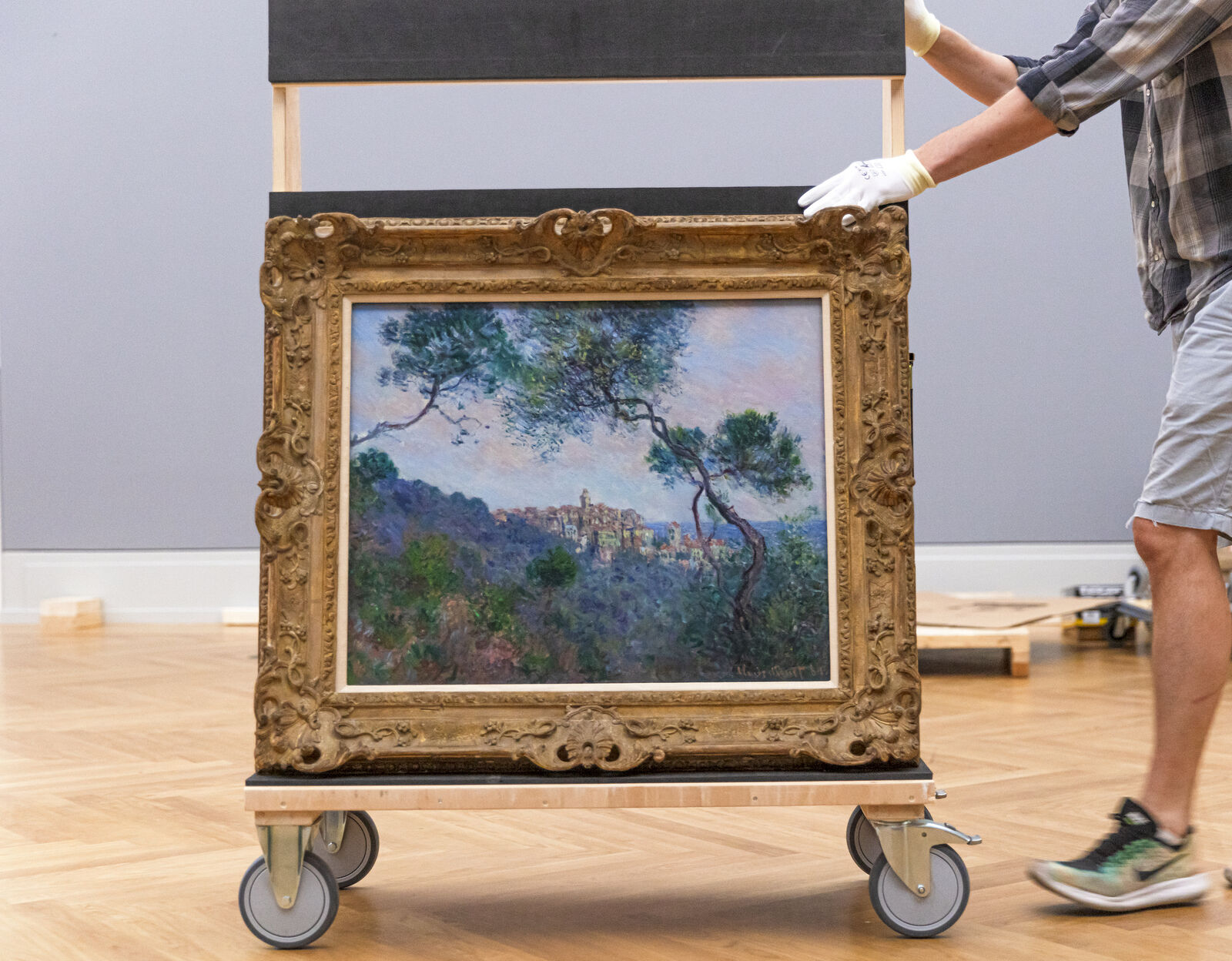
David von Becker
Paintings on Tour
The Museum Barberini is presenting over 110 works of French Impressionism and Post-Impressionism from the Hasso Plattner Collection, including masterpieces by Monet, Caillebotte, Renoir, and Signac. Occasionally, individual paintings will be lent to international exhibitions to support ongoing study of an artist and his oeuvre. Here you can read which of our pictures have traveled
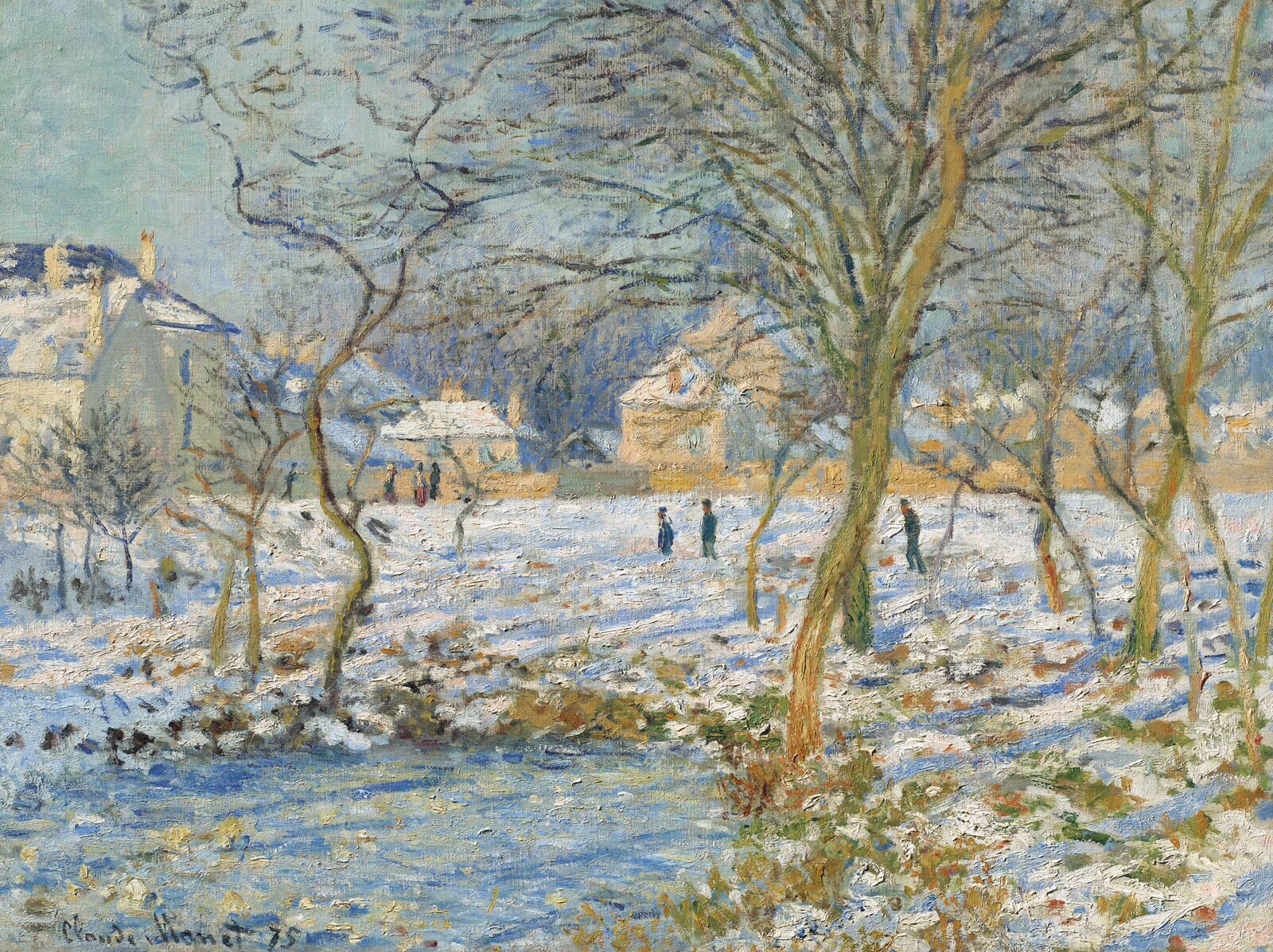
Claude Monet: The Pond, Snow Effect, 1874/75, Hasso Plattner Collection
Claude Monet: The Pond, Snow Effect, 1874/75
Claude Monet's The Pond, Snow Effect is on loan to the National Gallery of Canada in Ottawa for the exhibition Winter Count: Embracing the Cold from November 21, 2025, to March 8, 2026. The exhibition reflects on the significant influence of winter on various cultures and forms of artistic expression. With more than 150 works from the early 19th century to the present, it brings together Indigenous, Canadian settler, and European perspectives on this theme.
Claude Monet's The Pond, Snow Effect was created after the artist's return from London, where he had sought refuge during the Franco-Prussian War of 1870/71. Like many of his artist friends, Monet did not return to Paris, but moved to one of the smaller towns on the Seine that were easily accessible from the capital.
In the midday sun, people stroll across the open, snow-covered field near Monet's home in Argenteuil. Monet captured the carefree moment and the abundance of light, contrasting complementary yellow with blue and orange with violet.
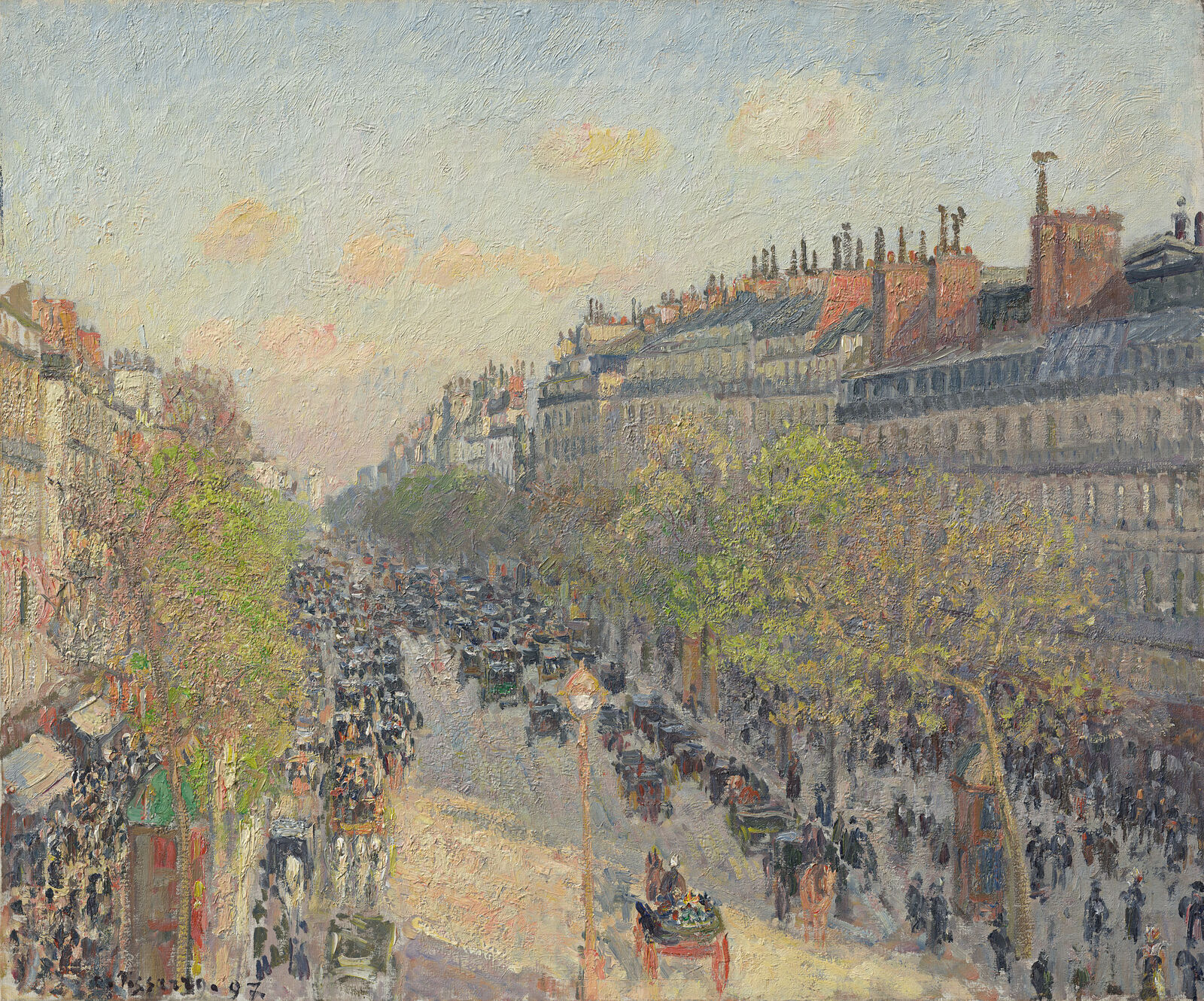
Hasso Plattner Collection
Camille Pissarro: Boulevard Montmartre, Twilight, 1897
Camille Pissarro: View of Bazincourt, Sunset, 1892 / The Hills at Le Chou, Pontoise, 1882 / View of Bazincourt, Snow Effect, Sunset, 1892 / Boulevard Montmartre, Twilight, 1897 / Garden and Henhouse at Octave Mirbeau's, Les Damps, 1892 / Hoar-Frost, Peasant Girl Making a Fire, 1888
From October 26, 2025, to February 8, 2026, these six works by Camille Pissarro will be part of the exhibition The Honest Eye: Camille Pissarro’s Impressionism at the Denver Art Museum. Denver is the second stop for the comprehensive Pissarro retrospective, which was on display at the Museum Barberini from June 14 to September 28, 2025.
Camille Pissarro is considered a founding figure of the Impressionist movement in France. However, his artistic beginnings were in the Caribbean and South America. These roots were combined with a painterly interest in rural everyday scenes and sympathies for anarchism. Pissarro's motifs are often simple, their tone subdued. Only at second glance does the appeal of their carefully observed details and carefully coordinated harmonies become apparent, arising from the artist's respectful, idealistic attitude, his openness, and his willingness to experiment. The variety of subjects in his paintings includes landscapes and gardens, family portraits, scenes of rural life, and urban motifs such as the ports of Normandy and the bustling streets of Paris. With over 100 works from 50 international collections, the exhibition provides a comprehensive overview of Pissarro's entire oeuvre and at the same time reveals the social utopian ideas behind his art.
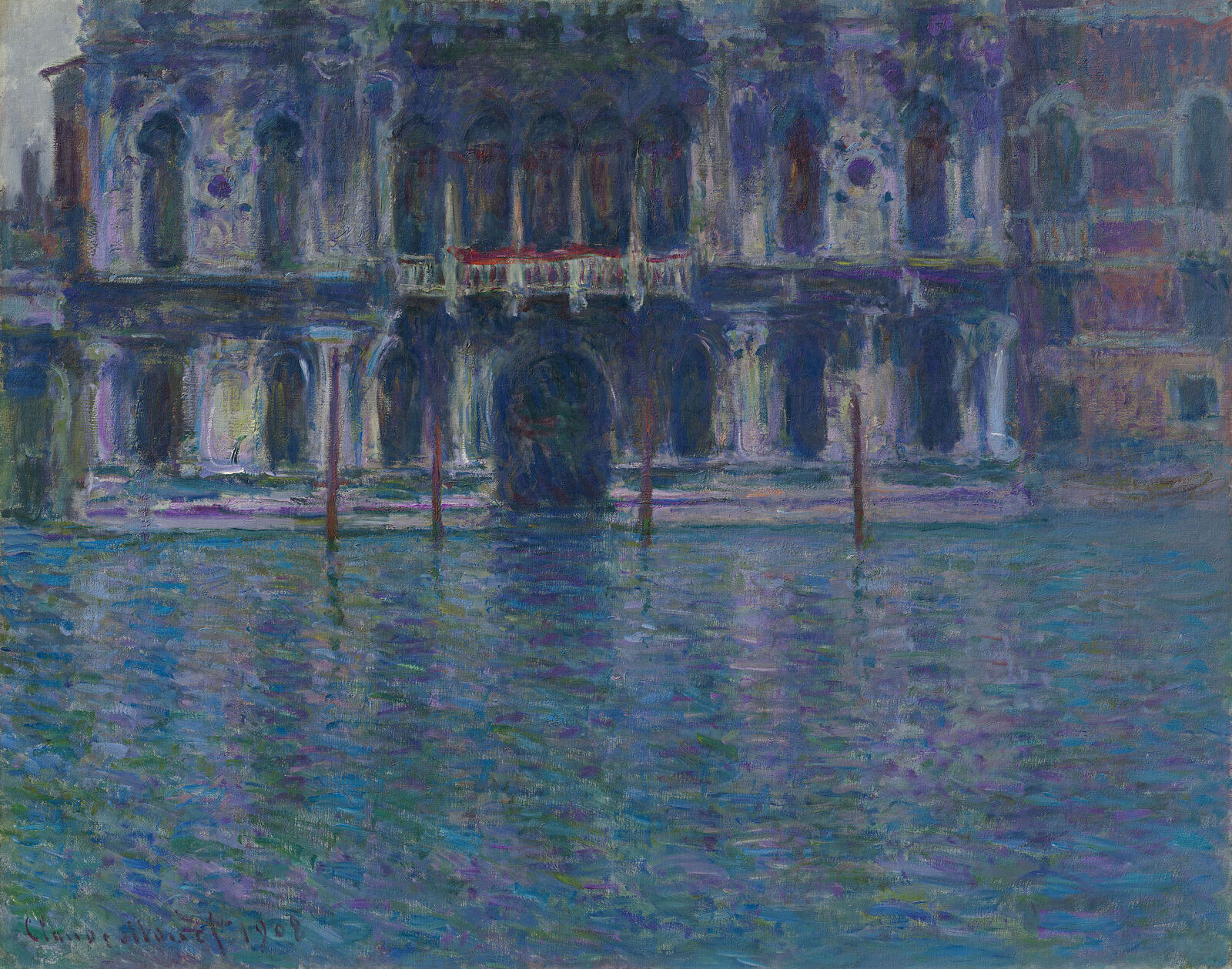
Hasso Plattner Collection
Claude Monet: The Palazzo Contarini, 1908
Claude Monet: The Palazzo Ducale, 1908 / The Rio della Salute, 1908 / The Palazzo Contarini, 1908
From October 11, 2025, to February 1, 2026, Claude Monet's works The Palazzo Ducale, The Rio della Salute, and The Palazzo Contarini are on loan for the exhibition Monet and Venice at the Brooklyn Museum, New York. For the first time in over 100 years, the exhibition focuses on the comprehensive collection of works that Claude Monet created during his 10-week stay in Venice in 1908. Of the 37 cityscapes Monet painted of Venice, the Brooklyn Museum is showing 19 works and juxtaposing them with works by Canaletto, Paul Signac, John Singer Sargent, Pierre-Auguste Renoir, and others.
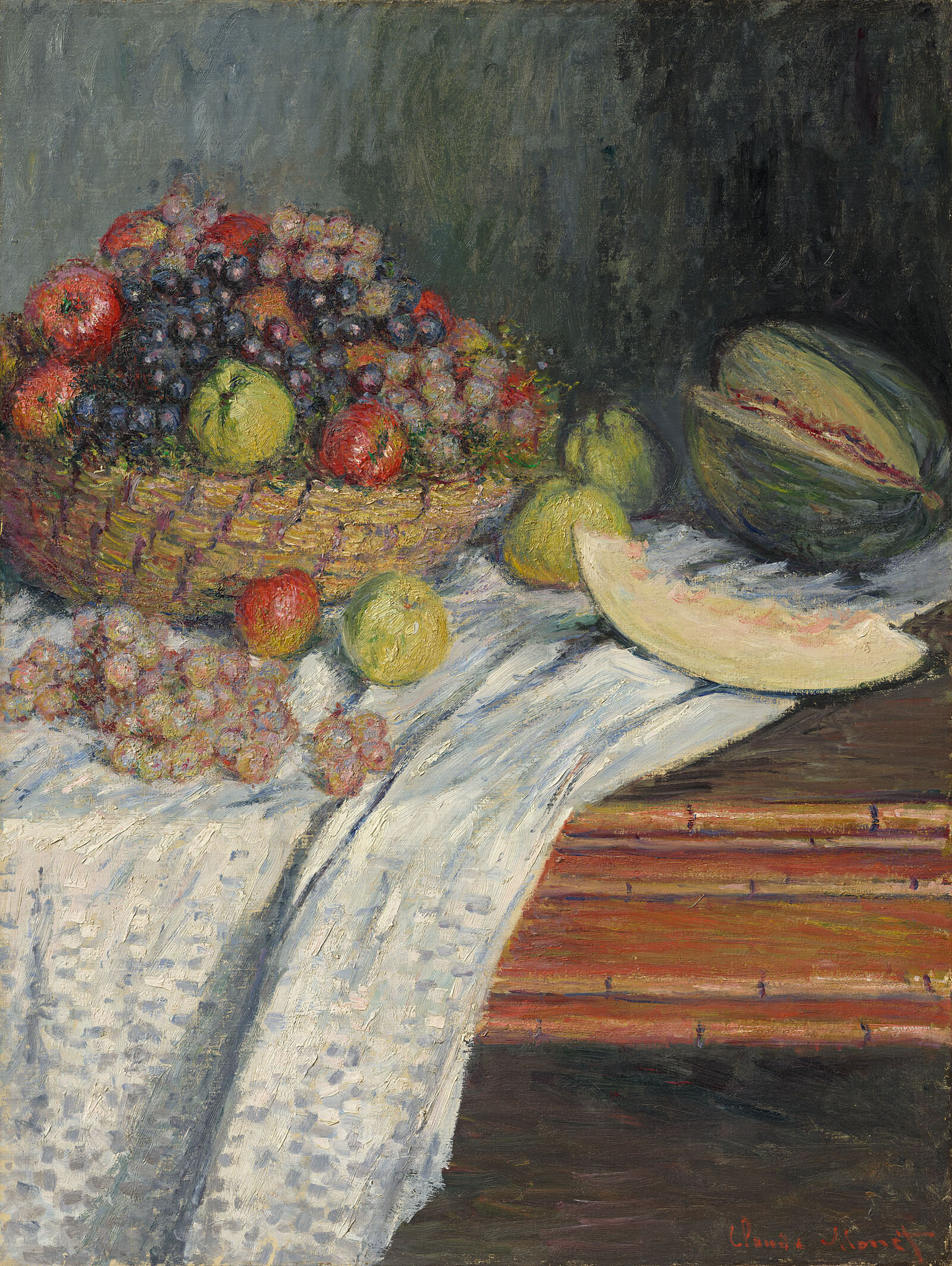
Claude Monet: Still Life with a Honeydew Melon, 1879
Claude Monet: Still Life with a Honeydew Melon, 1879
Claude Monet's Still Life with a Honeydew Melon will be on loan at the exibition Carl Schuch and France at Frankfurt's Städel Museum from September 24, 2025, to February 1, 2026.
The exhibition presents Carl Schuch as a restless 19th-century cosmopolitan who broke away from national attributions early on and devoted himself uncompromisingly to painting. During his lifetime, he was hardly known to the public, but after his death, the art world quickly recognized the quality of his work, before it later fell into oblivion again. The Städel Museum brings around 70 of Schuch's paintings into dialogue with some 50 works by French artists such as Paul Cézanne, Camille Corot, Gustave Courbet, Édouard Manet, and Claude Monet. The focus is on Schuch's years in Paris, where he experienced his most artistically formative creative phase from 1882 to 1894.
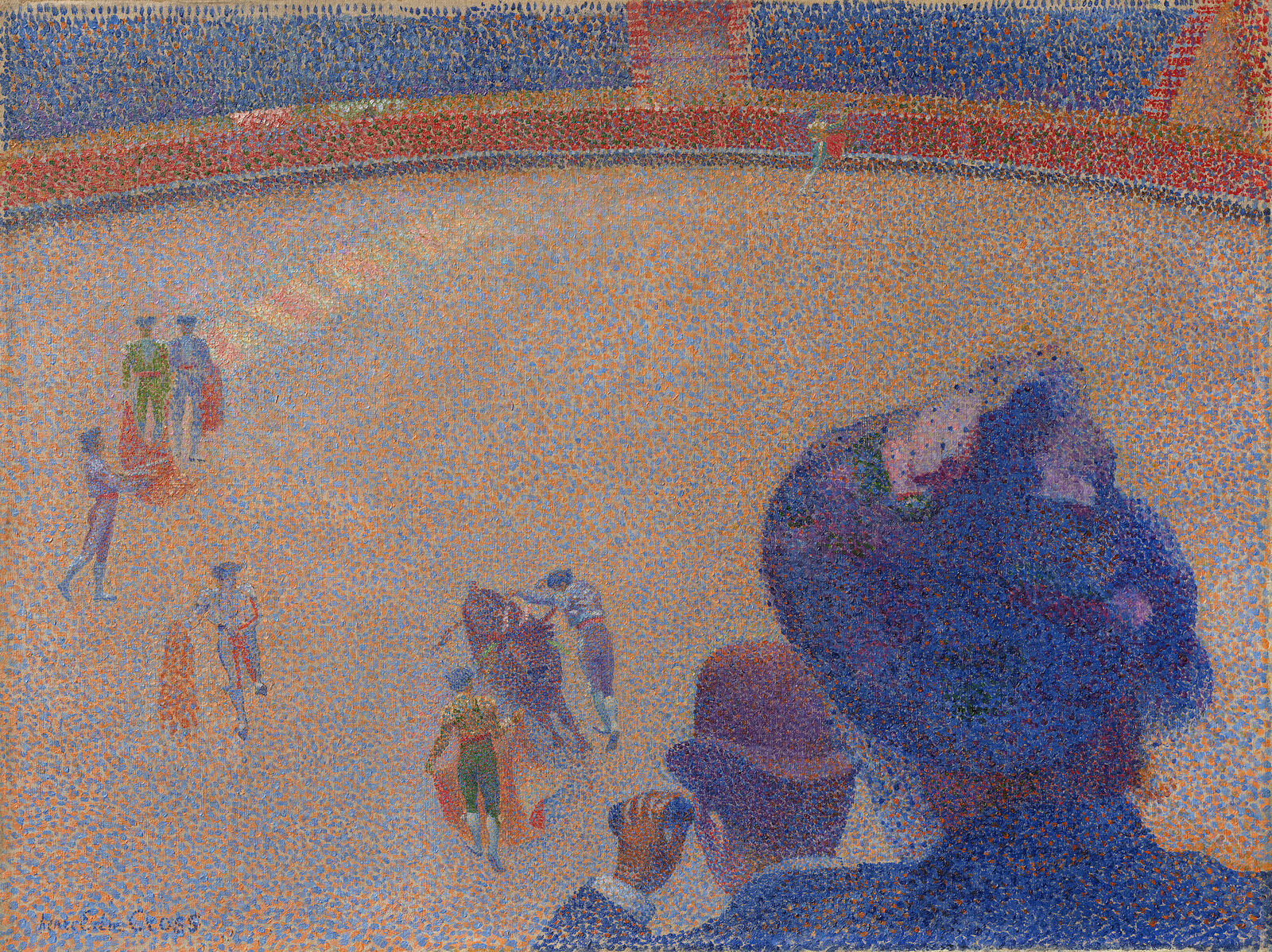
Hasso Plattner Collection
Henri-Edmond Cross: Bullfight, ca. 1891/92
Henri-Edmond Cross: Bullfight, ca. 1891/92
From September 13, 2025, to February 8, 2026, Henri-Edmond Cross's painting Bullfight will be on loan for the exhibition Radical Harmony: Helene Kröller-Müller's Neo-Impressionists at the National Gallery in London. The show brings together works of Neo-Impressionism from the collection of Helene Kröller-Müller, one of the earliest and most important art patrons of the 20th century.
Cross's painting Bullfight was created after the painter moved to Cabasson on the French Riviera, a town at the foot of the Maritime Alps, 45 kilometers west of Saint-Tropez, which Paul Signac had recommended to him. The year before, Seurat had shown his stage and circus scenes at the Salon des Indépendants. With his view from the spectator stands into the arena, Cross commemorates his artist friend, who had just passed away, and whose style he would continue to paint in from then on. The motif of bullfighting also points to the south, which became a new point of reference for the Neo-Impressionists after Seurat's death. In the Midi, bullfighting was seen as an expression of independence from the industrialized north of France and the metropolis of Paris. Cross's painting captures the bullfight with a fragmentary quality reminiscent of the new medium of photography.
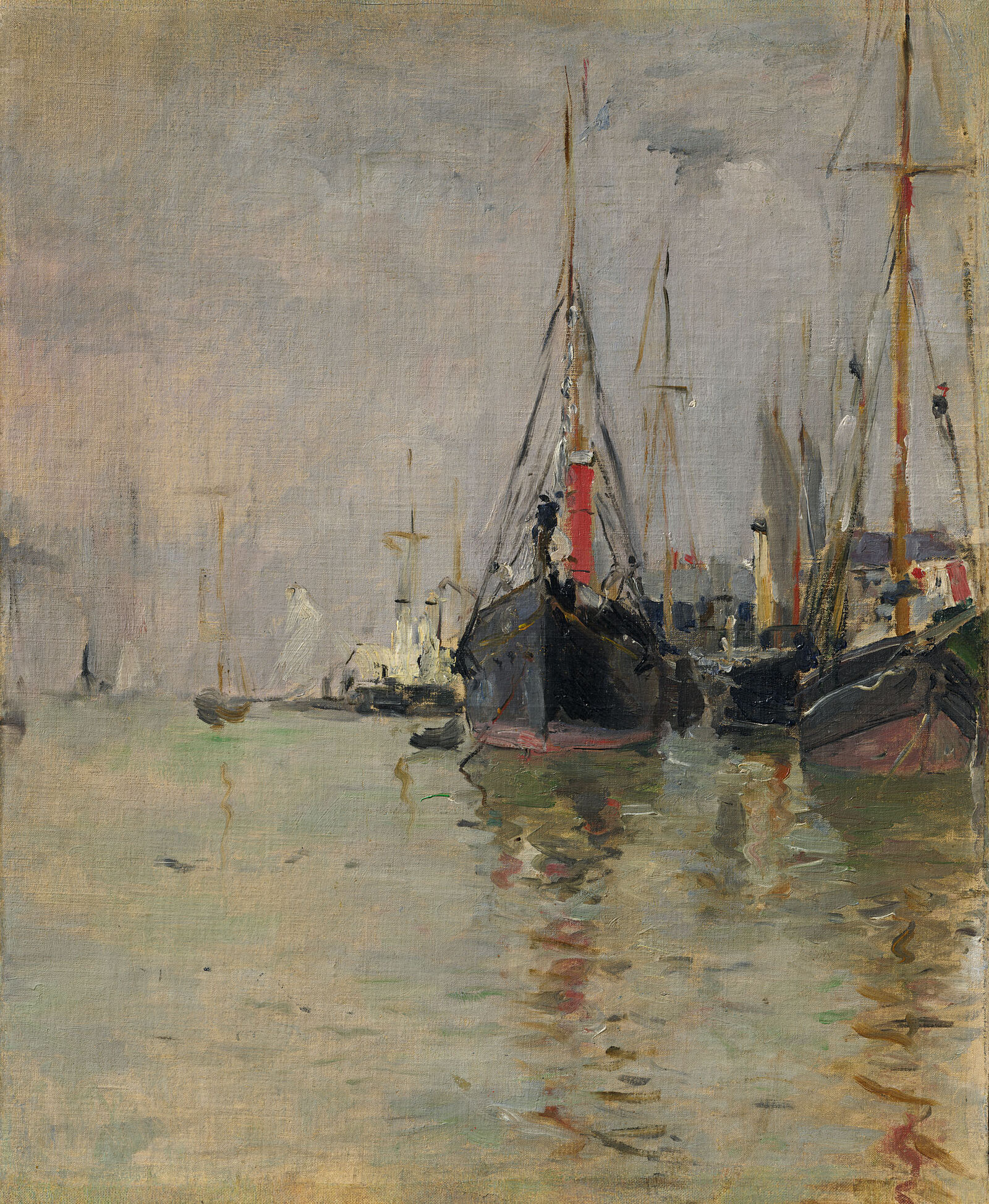
Berthe Morisot: The Thames, 1875
Berthe Morisot: The Thames, 1875
Berthe Morisot: The Thames, 1875
From June 14, 2025, to February 8, 2026, the painting will be on loan at the Kunsthalle Mannheim.
Past loans
2025
Raoul Dufy's painting The Beach of Sainte-Adresse (1906) was on display at the Kunst Museum Winterthur until May 18, 2025.
Dufy turned his view to the pier in this painting of the beach in Le Havre. Unlike the Impressionists, Dufy’s beach scenes are no longer illuminated by the variable light of a cloudy sky. Dufy’s skies are rendered in an impenetrable blue devoid of atmospheric qualities.
All nine of Maurice de Vlaminck's paintings from the Hasso Plattner Collection were be on display at the Von der Heydt Museum in Wuppertal from February 16 to May 18, 2025, as part of the exhibition Maurice de Vlaminck: Modern Art Rebell.
Maurice de Vlaminck (1876-1958) is one of the most important French modernist painters and was a member of the group known as the Fauves ("Wild Ones"), which formed around Henri Matisse and André Derain in 1905. Following the presentation at the Barberini Museum, the first posthumous retrospective of the artist's work in Germany can now be seen at the Von der Heydt Museum, bringing a central figure of 20th-century French art back into the public eye. With more than 50 selected paintings, the exhibition provides a valid overview of his entire painterly oeuvre: from his first compositions from the beginning of the 20th century, to his famous Fauvist paintings, his experiments with Cubism inspired by Cézanne and Picasso and his last landscape paintings, in which he developed a highly individual style of late Impressionism.
The paintings were part of the exhibition Monet and the Impressionist Cityscape at the Alte Nationalgalerie, Berlin, from September 27, 2024 to January 26, 2025. The artworks Boulevard Montmartre, Twilight, 1897, by Camille Pissarro, Rue Halévy, View from a Balcony, 1877, and Rue Halévy, View from the Sixth Floor, 1878, by Gustave Caillebotte, were also on loan to the second stop of the exhibition at the Kunstmuseum Den Haag, where the show was on display from February 15 to June 9, 2025.
Monet’s series of paintings from 1867 cast a new creative eye on the modern city. The artist did not visit the famous Louvre to copy works of the Old Masters, as was customary, instead painting the vibrant life of Paris from his balcony. In doing so, he literally turned his back on art historical tradition and concerned himself with the present in the growing metropolis. Beginning with these works, the exhibition Monet and the Impressionist Cityscape traced the rediscovery of the city as a motif by Impressionist and Post-Impressionist artists following in the tradition of Monet (1840–1926) and ranging from Maximilien Luce (1858–1941) to Henri Matisse (1869–1954). This concise exhibition on the Impressionist cityscape comprised around twenty works of painting, photography and graphic art.
Gustave Caillebotte's work Couple on a Walk has been on loan to the Musée d'Orsay in Paris for the exhibition Caillebotte Painting Men from October 8, 2024 to January 19, 2025.
More than the other painters in the Impressionist group, Gustave Caillebotte (1848-1894) always demonstrated a real predilection for male figures. Described by Gustave Geffroy as a “pictorial chronicler of modern life”, he depicted the appearance and existence of the men of his time; those he knew well – his brothers and friends – as well as those he encountered on the boulevards just outside his home, from labourers to members of the bourgeoisie out for a stroll.
Caillebotte’s “realistic” yet highly personal approach to these figures is suffused with explorations of his own male identity (an upper-middle-class painter, enthusiast, sportsman and bachelor) – reflecting his aspirations of breaking away from the antagonisms of class – and with a kind of admiration or even desire for a modern male ideal that defies gender stereotypes. At the same time, his paintings reflect the restructuring that was taking place in late 19th-century society.
In the 1860s the seaside resorts in Normandy became the most popular summer retreats of the Parisian bourgeoisie. Caillebotte's Couple on a Walk shows a young couple (likely the artist and his partner, Charlotte Berthier) are strolling past the luxurious Villa italiennein Trouville. The red parasol adds an accent to the picture, in which fresh green tones are dominant. The depiction of the figures from behind allows viewers to put themselves in the role of the vacationers.
From September 27, 2024, to January 19, 2025, Claude Monet's The Parliament. Sunset was part of the exhibition Monet and London. Views of the Thames at The Courtauld Gallery, London.
Some of Claude Monet’s most remarkable Impressionist paintings were made not in France but in London. Begun during three stays in the capital between 1899 and 1901, the series — depicting Charing Cross Bridge, Waterloo Bridge and the Houses of Parliament — was unveiled in Paris in 1904. Monet fervently wanted to show them in London the following year, but plans fell through. To this day, they have never been the subject of a UK exhibition.
Monet began his series Houses of Parliament while visiting London from 1899 to 1901 and continued to develop them in his studio in Giverny. The towers of Westminster Palace stand out as deep blue silhouettes against the red-violet sky, colored by the setting sun amidst the characteristic London smog. As in the work of his role models J. M. W. Turner and James Abbott McNeill Whistler, they appear before a dramatic, cloud-filled sky or dissolve into the fog.
2024
Monets painting Skaters at Giverny was part of the exhibition En Jeu! Les Artistes et le sport at the Musée Marmottan Monet, Paris.
To coincide with the 2024 Olympic and Paralympic Games, held in Paris for the first time in 100 years, the Musée Marmottan Monet will be presenting an exhibition titled En Jeu! Artists and Sport (1870-1930) from 4 April to 1 September 2024. It will look at the visual history of sport between 1870 and 1930 via more than a hundred major artworks from public and private European, American and Japanese collections (Musée National du Sport, Nice; Musée d’Orsay; Centre Pompidou; Musée Fabre, Montpellier; National Gallery of Art, Washington; Yale University Art Gallery, New Haven; Peggy Guggenheim Collection, Venice, Museum Barberini, Potsdam, etc.).
The warm orange-yellow color of the setting sun, combined with pink and blue accents, dominates this composition, which Claude Monet arranged in an almost abstract way. The movement of the skaters and the inclination of the poplars lend a dynamism to the picture that is at odds with the bitter cold.
The painting The Cliff and the Porte d’Aval has been on view at the Fondazione Francesco Federico Cerruti per l'Arte at Castello di Rivoli in Torino, Italy, from November 24, 2023 to August 18, 2024.
The view that Monet selected for The Cliff and the Porte d’Aval was that from the top of the cliffs at Étretat, a good seventy-five meters above the sea. From there he was able to train his sights on the Porte d’Aval, a natural arch that since Courbet had been popular with painters and hence had become a tourist attraction.52 The viewer is looking southwest and sees the midday light shining straight down onto the clifftop, while the cliffs themselves are casting a shadow over the sea. Monet, however, cleverly draws the gaze along the cliffs and then out onto the ever-brighter surface of the sea, deeper and deeper into the pictorial space. For all the sublimity of the landscape motif, his aim in the paintings belonging to this group of works was not to generate a mood or to make us feel moved at the sight of something immeasurable. His paintings of the Porte d’Aval from several different perspectives and distances take the viewer with them into the landscape, unfurling a cinematographic sequence of images.
Both paintings by Alfred Sisley were part of the exhibition 1863 • PARIS • 1874: Revolution in Art – From the Salon to Impressionism, presented at the Wallraf-Richartz-Museum & Fondation Corboud, Cologne, from March 15 to July 28, 2024.
Few places and times have influenced art history as much as Paris in 1874, when the first exhibition of the later world-famous Impressionists such as Degas, Morisot, Monet, Renoir and Sisley took place there 150 years ago from April 15 to May 15. In spring 2024, the Wallraf-Richartz-Museum showed how these painters came to organize themselves outside of the official Salon exhibition of the Paris Academy and why their art was initially rejected and later celebrated worldwide. Under the title 1863 • PARIS • 1874: Revolution in Art, the museum in Cologne traced the exciting path of French painting from the Salon to Impressionism.
This winter picture Snow Effect in Louveciennes was painted in 1874—the year in which Alfred Sisley attracted attention with his participation in the First Impressionist Exhibition in Paris. The strong shadows cast in the foreground lead the viewer’s gaze to the group of strollers, lending an element of instantaneity to the painting.
The slender poplars with their delicate leaves in Alfred Sisley’s painting The Meadow at Veneux-Nadon lead the gaze into the depth of the picture space and give it stability in this wide summer landscape. Through a juxtaposition of shimmering fields of color and a reduction of motifs, Alfred Sisley lends an iridescent vitality and tension to the seemingly monotonous theme. Sisley exhibited the painting at the Seventh Impressionist Exhibition in 1882, in which the group focused on landscapes.
The painting was on display from March 29 to June 30, 2024 at the Musée des impressionnismes, Giverny in the exhibition Impressionism and the Sea.
In the context of the celebration of the 150th anniversary of the birth of Impressionism in 1874, the Musée des impressionnismes Giverny, France, organized an exhibition in spring 2024 entitled Impressionism and the Sea. Through the works of artists such as Eugène Boudin, Johan Barthold Jongkind, Claude Monet, Gustave Courbet and Paul Gauguin, the exhibition presented a new vision of the Impressionist artists’ attraction to the sea.
Les Petites-Dalles is a small bathing resort near Fécamp that is known for its shining white cliffs. Claude Monet chose a perspective that emphasizes their monumentality. For him the cliffs were not just a motif, but also a projection surface for reflected water and sunlight. The strong contrasts of color heighten the dramatic effect of the scene, in which Monet indicated the bathers using just a few dabs of paint.
2023
The two works were on display from October 20, 2023 to January 28, 2024 at the Ueno Royal Museum in Tokyo and from February 10, 2024 to May 6, 2024 at the Nakanoshima Museum of Art in Osaka in the exhibition Claude Monet: Journey to Series Paintings.
The exhibition, which was first shown in Japan in Tokyo and then in Osaka, focused on Monet's development of the series motif. From the idea of working on a motif several times and incorporating different lighting conditions, Monet gradually developed the goal of capturing a motif in a complete series in successive lighting conditions and seasons.
On display from the Hasso Plattner Collection were the early work The Port of Zaandam from 1871 and a painting of his most famous series motif, The Water-Lilies, from 1918.
This work was on display at the Finnish National Gallery, Ateneum Art Museum in Helsinki from October 20, 2023 to February 25, 2024 in the following exhibition: Color & Light – The Legacy of Impressionism.
Colour & Light introduced Impressionist and Neo-Impressionist art from the period 1860–1916. The exhibition featured renowned names in international art, such as Claude Monet, Auguste Renoir, Camille Pissarro and Alfred Sisley. These acclaimed international artists were presented side by side artists from the heyday of Finnish Colorism, from 1906 to 1916. In Finnish art, the shift towards a brighter palette led to new subject matters, as labor and wild nature gave way to the comforts of middle-class life, parks, sunbathing, and nudity.
Among the international artists included in the exhibition were Claude Monet, August Renoir, Alfred Sisley, Camille Pissarro, Alfred William Finch, Paul Signac and Theo van Rysselberghe. Finnish artists included in the exhibition were Alvar Cawén, Antti Favén, Magnus Enckell, Pekka Halonen, Ellen Thesleff, Verner Thóme, Yrjö Ollila, Tyko Sallinen and Wilho Sjöström, among others.
The work was on view from September 2, 2023 to January 21, 2024 in the exhibition Matisse, Derain and Friends. The Paris Avant-Garde 1904–1908 at the Kunstmuseum Basel, Switzerland.
In 1901, the young Émile-Othon Friesz met the painter Camille Pissarro in Paris, who strongly influenced him in his early days. Friesz's painting Scene in a Paris Brasserie shows how the painter incorporated Impressionist motifs and developed them in a Fauvist manner. Friesz captured the interior with dark contours and used white only for points of light.
The exhibition in Basel showed works of the Parisian avant-garde, to which Émile-Othon Friesz belonged.
Paris attracted artists from all parts of Europe at the beginning of the 20th century. The painters Henri Matisse, André Derain and Maurice de Vlaminck showed their works of the the south of France in the third Paris Autumn Salon. These pieces were influenced by the bright colors and Neo-Impressionist impulses of Paul Signac. Critics of this exhibition coined the term Fauve ("the savages") due to their striking use of color and expressive imagery. This led to the emergence of the term Fauvism.
The painting was part of the exhibition Renoir: The Painter and his Models at the Museum of Fine Arts, Budapest from September 21, 2023 to January 7, 2024.
For the first time, the work of Pierre-Auguste Renoir has been the focus of an exhibition in Hungary in 2023. In 2019, the Hungarian National Gallery was able to acquire the painting Reclining Nude (Gabrielle), a late masterpiece. The exhibition in Budapest showed Renoir's entire artistic development in sections arranged chronologically and thematically. The early portraits revealed the change in Renoir's approach depending on the status of his models (impressionist friends and official clients).
The Impressionists no longer used earth-based pigments and banished all earthy tones from their palettes, even those that were industrially produced. Thus, they steadily reduced the number of hues they worked with, as can be seen in the painting Path in the Forest by Renoir. Here, the cool colors set the mood, whose focus on the undergrowth ("sous-bois") as a motif in its own right connects it to the works of the Barbizon painters Narcísso Virgilio Díaz de la Peña and Camille Corot. Yet it was with these same cool pastel shades that Renoir achieved an airiness in the pictorial space, which is characteristic to Impressionist art.
The painting was part of the exhibition La Grande Bleue, Schilders van de Méditerranée (The Great Blue, Paintings at the Singer Laren) at the Singer Laren Museum in Laren (Netherlands) from September 12, 2023 to January 7, 2024.
The exhibition was dedicated to the discovery of the Mediterranean by European artists from Impressionism to Fauvism.
Cross and Signac’s month-long stays on the Côte d’Azur motivated the group as a whole to take more of an interest in the light conditions and the culture of the Mediterranean. These were the paintings that inspired younger artists such as Henri Matisse and André Derain, who embraced their celebration of light. Thus the artists took a stand against those stuffy, bourgeois Parisians, for whom the South of France was sleepy and underdeveloped and clung on to the cliché of the rebellious Southerner. Signac, like Monet in Giverny, became a magnet for young painters, who visited him in Saint-Tropez. Among them was Henri Matisse, who spent the summer of 1904 as a guest of Signac at his villa, La Hune. He also became acquainted with André Derain and, in 1901, with the autodidact Maurice de Vlaminck, with whom Derain shared a studio in Chatou, some ten kilometers west of Paris. Matisse visited the two artists there and was thrilled with their unconventional choice of palette, applied irrespective of the local colors.
The painting The Beach of Saint-Clair was on display at the Musée de l'Annonciade in Saint-Tropez from July 10 to November 14, 2023. It was part of the exhibition Cross in the light of the Var, the most beautiful country in the world (Saint-Tropez).
The show highlighted Henri-Edmond Cross as an important artist of Neo-Impressionism, whose works in bright colors are considered one of the pioneers of Fauvism. The Musée de l'Annonciade is set amid the countryside of the Var department, where Cross settled after arriving from the north in 1891 as one of the first Parisian artists of that generation. His works reflect the intense light and vibrant colors of the south. In their exploration of current research on color theories and complementary contrasts by Charles Blanc and Michel-Eugène Chevreul, the Neo-Impressionists increasingly focused on the use of pure colors. More and more they avoided brightening up the chromatic colors with white, and rather began instead to represent light as a juxtaposition of colored dots. At his invitation, Paul Signac also came to St. Tropez to settle there.
This painting was presented in the exhibition Léon Monet. Brother of the artist and collector in the Musée du Luxembourg, Paris, from March, 15, to July, 16, 2023.
It was painted in 1874, the year of the first impressionist exhibition in Paris. Together with several other winter themes of Sisley it was shown two years later in the second exhibition of the community. The sky is almost cloudless, and the air cold and crisp. Dominating the foreground is a triangular blue shadow falling off the roadside, whose apex points at the three figures walking toward the convergence of two fields. It shows the edge of the village under a somewhat overcast sky. The people in Sisley’s landscapes characterize village life, but without turning them into genre scenes like those that were still popular even at the Salons of the 1880s. The impression the viewer sometimes has of seeing one and the same figure in more than one painting lends them a continuity that in turn emphasizes their quality as parts of a larger whole or series. The snowy winters enabled Sisley to create a harmonious unity of landscapes.
This work is one of a pair of paintings of the snow-swathed road to Louveciennes from 1874. Snow Effect in Louveciennes shows the same road on a clear winter’s day, but at an angle that has shifted slightly to the right. The fence is a feature of both canvases. It belongs as well to the Hasso Plattner collection and can be seen in this room.
With a total of five paintings by Claude Monet from the Hasso Plattner Collection, the Museum Barberini was the main lender and most important partner of this exhibition Monet – in Full Light, which ran from July 8 to September 3, 2023, at the Grimaldi Forum Monaco. It included Monets works The Rose Bushes in the Garden at Montgeron, 1876, Villas in Bordighera, 1884, Strada Romana at Bordighera, 1884, Bordighera, Italien, 1884, and The Fort of Antibes, 1888.
In 1883, halfway through his long life and settling in at Giverny, Claude Monet, still in search of inspiration, made his first trip to Monte Carlo and the Riviera, which he discovered with his friend Pierre-Auguste Renoir. He returned alone in 1884 and again in 1888. In Monte-Carlo, Roquebrune, Bordighera and Antibes, he nourished his quest, his obsession, to capture light. As a northern painter, he discovered a new palette of colors, new elements, and found it difficult to paint them. It was during his final stay in Antibes in 1888, that he envisioned his famous series painting from the Salis beach, the fort of Antibes in all the seasons.
As a loan, the painting Boulevard de Clichy was part of the exhibition Picasso Landscapes: Out of Bounds at the Mint Museum in Charlotte, North Carolina (USA), from February 11 to May 21, 2023. From June 24 to October 15, it was on view at the Cincinnati Art Museum.
This work by the nineteen-year-old Pablo Picasso was created during one of his first stays in Paris. After visiting the world exposition in 1900, he traveled from Barcelona to the French capital once more the following year. Boulevard de Clichy, painted the same year, reflects Picasso’s encounter with Impressionism and Pointillism. In particular, the Paris scenes of Camille Pissarro seem to have inspired the young painter to explore the motif of the street as seen from his window in the artists’ quarter of Montmartre.
This cityscape shows how he responded to the encounter with the French art of the turn of the century, before finding his way through the Blue and Rose Periods as well as Cubism to his own distinctive style.
The painting Klipper by Paul Signac was on view at the Art Institute Chicago from May 14 to Sept. 4, 2023, in the exhibition Van Gogh and the Avant-Garde. The Modern Landscape. The Van Gogh Museum Amsterdam presented this exhibition from 10/13-23 to 1/14-24 under the title Van Gogh along the Seine. This was a joint exhibition project under different titles.
Signac's Klipper was painted in 1887, and stylistically it shows how the artist processed the impulses of Impressionism while experimenting with juxtaposed color points of the emerging Divisionism. Signac staged the clash of light and shadow on the bridge piers as a dot structure. He used the complementary colors orange and blue as well as yellow and violet. In the background, the then modern industrial architecture outside Paris along the Seine can be seen, with which some French artists left the sophisticated life of the metropolis behind them in terms of motifs.
2022
This painting was part of the exhibition Face au Soleil. Un Astre dans les Arts, on view at the Musée Marmottan Monet in Paris from September 14, 2022, to January 19, 2023. From February 25 to June 11, 2023, the show will be presented at the Museum Barberini in Potsdam under the title The Sun: Source of Light in Art.
The point of departure for the exhibition is Claude Monet’s painting Impression. Soleil levant (Impression, Sunrise), which was celebrating its 150th birthday in 2022. Focusing on the motif of the sun in art, the show brings together works from a variety of epochs, cultures, and media, from the ancient vase to the twenty-first-century video. Artists represented include Albrecht Dürer, Peter Paul Rubens, Caspar David Friedrich, Edvard Munch, and Otto Dix. The exhibition in Paris featured three works from the Hasso Plattner Collection: this painting by Signac along with one work each by Camille Pissarro and Eugène Boudin.
This Pointillist work by Signac is composed of countless precisely placed dots of color. The port entrance of Saint-Tropez—which at that time was still a small fishing village—glows in luminous colors, an effect Signac produced by juxtaposing complementary hues of yellow and violet. The artist had discovered the south of France at the invitation of his friend Henri-Edmond Cross. He acquired a house at the seaside in Saint-Tropez and, bringing along his yacht Olympia, settled there permanently. This iconic work was painted shortly thereafter.
This painting was part of the exhibition Face au Soleil. Un Astre dans les Arts, on view at the Musée Marmottan Monet in Paris from September 14, 2022, to January 19, 2023. From February 25 to June 11, 2023, the show will be presented at the Museum Barberini in Potsdam under the title The Sun: Source of Light in Art.
The point of departure for the exhibition is Claude Monet’s painting Impression. Soleil levant (Impression, Sunrise), which was celebrating its 150th birthday in 2022. Focusing on the motif of the sun in art, the show brings together works from a variety of epochs, cultures, and media, from the ancient vase to the twenty-first-century video. Artists represented include Albrecht Dürer, Peter Paul Rubens, Caspar David Friedrich, Edvard Munch, and Otto Dix. The exhibition in Paris featured three works from the Hasso Plattner Collection: this painting by Pissarro along with one work each by Eugène Boudin and Paul Signac.
Claude Monet and Camille Pissarro met as young artists in London in 1870. From then on they enjoyed an intensive artists’ friendship as both of them developed their Impressionist handwriting. Through the influence of Seurat and Signac, Pissarro occasionally worked in the Pointillist style. Here, the pale sunlight bathes the sky and trees in a warm glow, while at the same time the snow-covered landscape evokes the sensation of a cold winter evening.
The same year, Pissarro painted View of Bazincourt, Sunset, which shows the same landscape with green meadows under a fiery sunset. It also belongs to the Hasso Plattner Collection.
This painting was part of the exhibition Face au Soleil. Un Astre dans les Arts, on view at the Musée Marmottan Monet in Paris from September 14, 2022, to January 19, 2023. From February 25 to June 11, 2023, the show will be presented at the Museum Barberini in Potsdam under the title The Sun: Source of Light in Art.
The point of departure for the exhibition is Claude Monet’s painting Impression. Soleil levant (Impression, Sunrise), which was celebrating its 150th birthday in 2022. Focusing on the motif of the sun in art, the show brings together works from a variety of epochs, cultures, and media, from the ancient vase to the twenty-first-century video. Artists represented include Albrecht Dürer, Peter Paul Rubens, Caspar David Friedrich, Edvard Munch, and Otto Dix. The exhibition in Paris featured three works from the Hasso Plattner Collection: this painting by Boudin along with one work each by Camille Pissarro and Paul Signac.
In Le Havre: Sunset on the Sea, Eugène Boudin captures the light of the setting sun in delicate tones of yellow, orange, and pink. The luminous, whitish-yellow disk of the sun stands out on the horizon; it is the only element with sharp contours, while the other forms dissolve in the fading light. The low horizon in many of Boudin’s paintings allowed ample space for his masterful depiction of the heavens, which earned him the nickname “king of the sky.” Boudin is considered the first teacher of Claude Monet, whom he introduced to plein air painting.
The Museum Barberini granted this painting as a loan to the exhibition The Wind. That Which Cannot Be Painted, the work was on view at the Musée d’art moderne André Malraux in Le Havre for from June 25 to October 2.
In 1883, Claude Monet moved to Giverny, where he renovated the vacant building of an old cider press (Le Pressoir) to serve his needs and those of his family. Here he was to reside until the end of his life.
Even after his move to Giverny, Monet continued to paint the rural environment along the Seine. Here he directs our gaze across the tall grass toward the children playing in the field. The meadow appeals to all of our senses. The blades of grass feel so close we could touch them; they embody the light and warmth of the spring day and evoke the fresh scent of a pasture landscape.
There is no path to lead our gaze into depth. Rather, the broad meadow and the sky framed by trees create two equally important fields of projection for the effects of the sun and the wind. This approach is typical of Monet. As he himself stated, his concern was to depict not the motifs in and of themselves, but that which surrounded them: air and light. This he described using the French word envelope — the envelope surrounding visible things.
The Museum Barberini granted this painting as a loan to the exhibition Le Décor impressionniste, which was on view at the Musée de l'Orangerie in Paris from March 2 to July 11, 2022.
The exhibition at the Musée d’Orsay explored the Impressionist turn to décor and decoration – a preoccupation that culminated in Claude Monet’s large-scale Water Lilies cycle at the Musée de l’Orangerie in the 1920s. In addition to numerous paintings by Mary Cassatt, Edgar Degas, Claude Monet, and Pierre-Auguste Renoir, among others, the 80 works on display also included fans, ceramics, and works on paper. From the Hasso Plattner Collection, Monet’s Rose Bushes in the Garden at Montgeron was on view: a study for the large-scale painting Garden Corner in Montgeron (ca. 1876, State Hermitage, Saint Petersburg), commissioned by the textile magnate Ernest Hoschedé as a wall decoration for his residence, the luxurious Château de Rottembourg.
The Museum Barberini has granted this painting as a loan to the exhibition I: Max Liebermann – A European Artist. It was on view at the Hessisches Landesmuseum Darmstadt from October 8, 2021, to January 8, 2022, and at the Kunstpalast Düsseldorf from February 2 to May 8, 2022.
As a driving force of nineteenth-century German painting, Max Liebermann was closely connected with the wider European art scene. The painting traditions of France and the Netherlands, in particular, played a significant role in his work. The exhibition addressed Liebermann’s engagement with his European forebears and contemporaries, including Jean-François Millet and Claude Monet, and provided a direct juxtaposition with selected works. Among the numerous lenders were the Nationalgalerie in Berlin, the Musée d’Orsay in Paris, the Kunstmuseum Den Haag, and the Teylers Museum in Haarlem.
This painting was granted as a loan for the exhibition The Art of Pál Szinyei Merse, which was on show at the Hungarian National Gallery in Budapest from November 11, 2021 to February 20, 2022.
Pál Szinyei Merse is one of the most important pioneers of modernism in Hungary. For his landscape paintings that he created in the 1870s and 1880s, he adopted the plein-air technique that had become a hallmark of French Impressionism by the end of the 19th century. The exhibition at the Szépművészeti Múzeum situated Szniyei’s work in the international context of his time, while also considering parallels with developments in France. Claude Monet’s Under the Poplars from the Hasso Plattner Collection was shown in the exhibition in a dialogue with Szniyei’s stylistically closely related work Poppy Field (1896).
This painting was granted as a loan to the exhibition Tracks to Modernity, which was on view at the Musées Royaux des Beaux-Arts de Belgique in Brussels from October 15, 2021, to February 13, 2022.
Progress and modernization were central themes in the work of Gustave Caillebotte. The Argenteuil Bridge and the Seine is one of several paintings in which the Impressionists traced the rapidly advancing infrastructure in the Parisian countryside. In a radical rejection of established compositional formulas, Caillebotte has focused on just one of the metal bridge’s seven arches – an unusual pictorial arrangement that bears witness to the influence of contemporary photography. In the left-hand background, the artist included a view onto the highly modern railway bridge through which Argenteuil enjoyed a direct connection to the Gare Saint-Lazare in Paris since 1851. The exhibition in Brussels focused on the painterly fascination with the rapid changes brought about by the growing national and international interconnection, which the train facilitated as a new and quintessentially modern means of transportation.
2021
This painting was granted as a loan to the exhibition Caillebotte: Impressionist and Modern, which was on view at the Fondation Pierre Gianadda in Martigny from June 18 to November 21, 2021.
With his participation at the second Impressionist Exhibition in Paris in 1876, Gustave Caillebotte joined the burgeoning movement around Claude Monet. For a long time, his own contribution as a painter remained overshadowed by his fame as one of the earliest important patrons and collectors of Impressionism. The Fondation Pierre Gianadda revisited his entire development as an artist in a monographic show that assembled around 90 selected paintings. Amongst the numerous international lenders were the National Gallery of Art in Washington, the Petit Palais in Geneva as well as the Musée Marmottan Monet and the Musée d’Orsay in Paris. With overall six paintings, the Collection Hasso Plattner boasts the most significant holdings of works by the artist in Germany.
This painting was granted as a loan for the exhibition “Gardenside: From Monet to Bonnard", which was on view at the Musée des impressionnismes in Giverny from April 1 to November 1, 2021.
The garden was a key theme of Impressionist and Post-Impressionist painting. The exhibition at the Musée des impressionnismes examined this motif at the intersection between the Impressionists around Claude Monet and the Nabi painters around Pierre Bonnard and Édouard Vuillard. Assembling around 100 paintings, drawings, and prints, it traced the role of the garden as the expression of a new artistic sensibility, marked by a longing for the harmonious union of man and nature. In light of his sympathies for anarchist ideals (including a belief in nature as a source of individual and social regeneration), the work of Camille Pissarro was key to this project. In addition to the painting from the Hasso Plattner Collection, the exhibition included several other important works by the artist, amongst them loans from the Musée d’Orsay in Paris and the Musée d’art moderne André Malraux in Le Havre.
This painting was granted as a loan for the exhibition Monet in Étretat, on view at the Seattle Art Museum from July 1 to October 21, 2021.
In the 1880s, Claude Monet spent several painting stints at the Northern French fishing village of Étretat. There, he executed around 80 compositions, many of which evolved as variations around one and the same motif. Taking its cue from one of the works in its own collection (Fishing Boats at Étretat from 1885), the Seattle Art Museum explored the role of Étretat in Monet’s artistic evolution. The painting from the Hasso Plattner Collection was displayed in the context of other compositions, in which the artist focused on the dramatic rock formation of the so-called Porte d’Aval.
This painting was granted as a loan for the exhibition “Bon Voyage, Signac!”, which was on view at the Wallraf-Richartz-Museum in Cologne from April 16 to August 22, 2021.
With Paul Signac’s Constantinople: Yeni Djami (1909), the Wallraf-Richartz-Museum in Cologne houses one of the artist’s late key works. The painting was the focus of the exhibition “Bon Voyage, Signac!”, which was laid out as an impressionist journey through the museum’s own collection and which, in addition to Signac, also included paintings by Gustave Caillebotte, Paul Cézanne, Henri Matisse, Claude Monet and Vincent van Gogh. This museum’s own holdings of around 60 works were enriched by nine important Signac loans from collections in Europe and the USA, including paintings from the Musée d’Orsay in Paris and the Metropolitan Museum of Art in New York.
The Museum Barberini supported the project with Signac’s The Port at Sunset (1892) – one of the first compositions the artist produced after his move to the Côte d’Azur. With a total of four works, the Hasso Plattner Collection has the most extensive holdings of Signac paintings anywhere in Germany.
To the collection